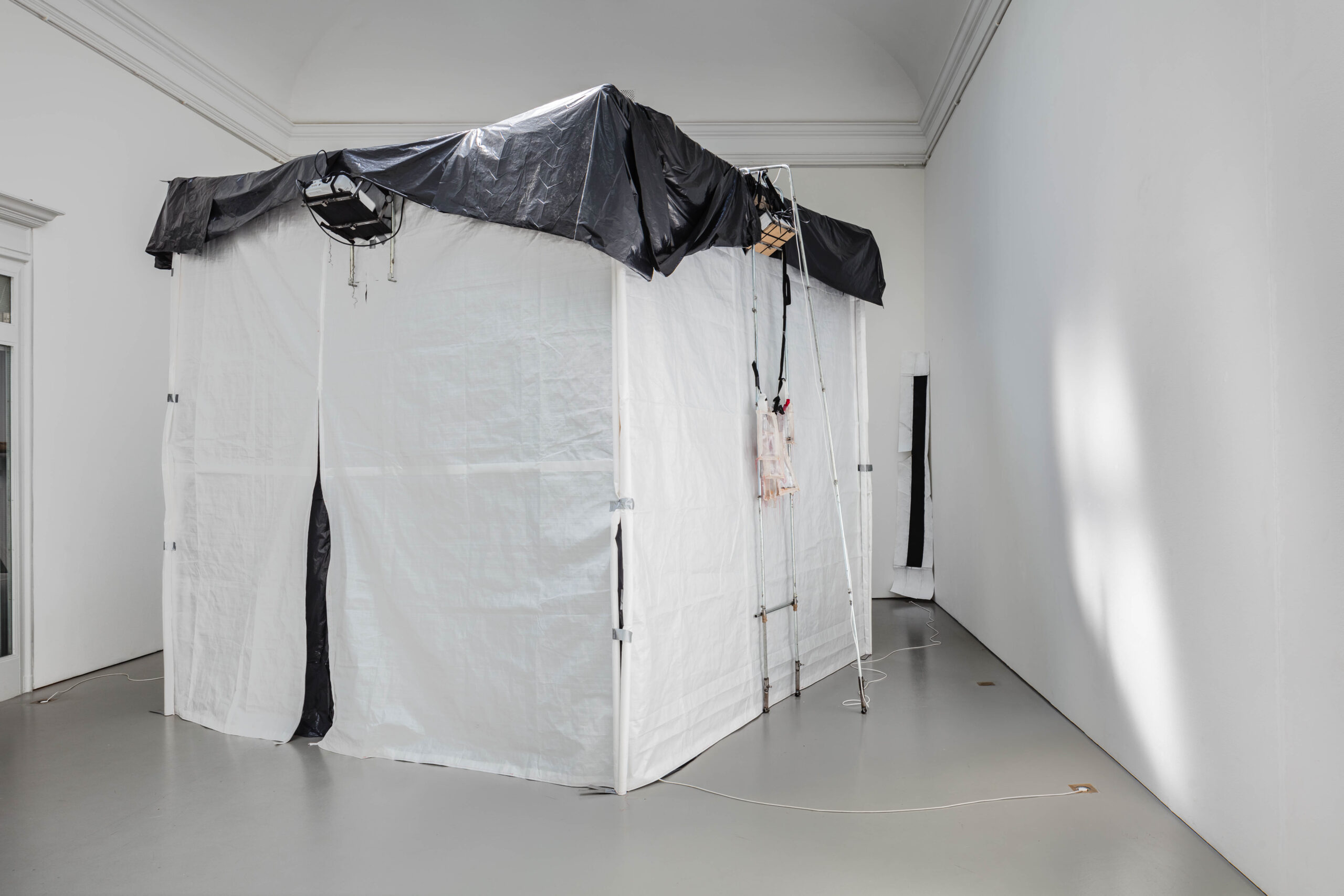The annual exhibition at Bonniers Konsthall by grant recipients sometimes means vastly different artists share the same space. Unexpected encounters may occur, as well as exciting dialogues between artists’ works, styles and themes. This year’s recipients, Ida Idaida and Fathia Mohidin, share common interests in machinery, the body and a recurrent state. They play with an industrial aesthetic where rhythmic and repetitive sounds from machines and moving bodies are interwoven and repeated. At Bonniers Konsthall, both artists seize the space and transform it; one into a place for the unconscious mind, trauma and horror, and the other into a place for exercise, performance and labour.
Ida Idaida and Fathia Mohidin
2 dec 202010 jan 2021
Ida Idaida often works with advanced, large-scale sculptural machinery that she establishes like wraiths in the exhibition space. Her work is a way to transfer corporeal experiences, energies and processes in other objects and thus let them convert the energy once more. The works become a way to materialise inner, hidden processes into new observable cycles. The work Truth is not delivered whole but received in parts a rotten corpse flesh slushed acid rain burn the scars embodies inherited suffering, that is transferred through genetics and cloned from one generation to the next. The visitor is encouraged to step into the installation and participate in this distorted world with its own automated lifecycle for flies. Cycles and repetition are central concepts in Idaida’s works. Through pieces such as Trasa (From flesh to meat from meat to flesh) she examines repetitive and circular patterns as a symptom of trauma and how this manifests itself outside one´s own body.

Fathia Mohidin focuses on labour and exercise as her point of departure for considerations about the body. At Bonniers Konsthall she presents spatial installations where the machine is hidden to the eye, but if you listen carefully it will gradually appear: rhythmic and ambivalent sounds from machines at work or physical activity. Mohidin’s works derive from physical research where she, putting her own body through physical stress, investigates notions of work, performance and the gym as a place for commodification (the process by which a person is transformed into a product). In the video work KIN and the sculptural objects in Roll Deep, we encounter fitness equipment minus the presence of bodies. Placed alone, these objects pose questions about what the body is actually meant to do with them, and likewise what the objects are meant to do with the bodies. Mohidin’s installations are often sound- or smell-based works, such as the black rubber matting that covers the entire floor of one of the exhibition halls, the strong smell forcing the eye to make way for other senses.

The Maria Bonnier Dahlin Foundation was founded in 1985 by Jeanette Bonnier in memory of her daughter Maria who died in a car accident that year just 20 years of age. Maria studied architecture at Columbia University in New York and moved in a circle of young artists. Since then, the Foundation has always sought out the new and innovative, and several of those who have received the grant are now some of Sweden’s most renowned contemporary artists.
From the jury’s statement
The guest jury for the 2020 grant was curator Jonatan Habib Engqvist and artist Lina Selander, herself a former grant recipient.
Ida Idaida is awarded the MBD grant for her tremendous craftsmanship, inventiveness and artistic finesse that create such complex and unexpected installations, which seem to exist in a zone beyond the human or somewhere all too human, where physiological and mental states break out and are embodied through material processes and movements.
Ida Idaida charts the transmission of suffering and violence across generations. Genetics and heredity show repetitive ghostlike patterns and effects. Violence is experienced again and repeated. It mutates and clones itself. In the midst of it all stands the machine-human hoarding its own violence as power and logic. With installations that cover a surprising choice of materials – hatching fly larvae, machinery, fluorescent tubes, bronze and solid oak – Ida Idaida creates complex, frightening and ingenious worlds.
Visitors find themselves in an obtuse course of events that seek space and reality. Repetition compulsion acts on the body, leaks into the surroundings and contaminates the perception of reality.
Fathia Mohidin is awarded the MBD grant for her way of highlighting, with architectural sensibility, the body’s relationship to political, social and economic structures. She creates tactile encounters that inhabit the viewer’s own body and remain there for a long time.
Fathia Mohidin’s performative method of examination is both physical and intellectual, and features the relationship between the corporeal and spatial. Through her works, we not only gain an insight, but also experience, purely via the senses, kinships between sport, art and everyday life in matters regarding performance, competition and the construction of national identity.
The starting point is a struggle one has not chosen. Traces of the slave trade and centuries of oppression live on and continue to influence the present day and are inscribed in the skin. Norms concerning femininity and whiteness are set against the involuntary opposition between the black female body and the white space. Rather than dwelling on issues of representation, there appears the inherited somatic experiences of the body’s continual conflict with society’s demands and expectations.